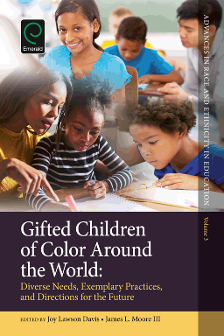Gifted Children of Color Around the World: Diverse Needs, Exemplary Practices, and Directions for the Future: Volume 3

Table of contents
(22 chapters)Abstract
The current status of indigenous gifted children and youth in an ethno-linguistic diverse Andean country is presented. The major purposes of this chapter are: (a) to describe gifted education in Peru, underlining the advocacy efforts toward the indigenous population; (b) to analyze the provisions for talent development in Peru; and (c) to present the challenges for the Peruvian indigenous gifted in the future, taking into consideration the needs and challenges of a multicultural society.
Abstract
Teachers advocating for increased engagement by culturally and linguistically different (CLD) students in gifted and advanced programs can use Community Problem Solving (CmPS) to promote cultural competence, positive future images, a future orientation, and critical and creative thinking skills. This chapter provides an overview of standards for developing cultural competence for working with CLD students (Ford & Whiting, 2008), taking into account principles of multicultural education (Banks & Banks, 2010) and stages within the Incubation Model of Teaching (Torrance & Safter, 1990). A guide is presented for teachers as culturally responsive coaches of CLD students in their use of CmPS to enhance their engagement in learning in gifted and advanced programs. In addition, the types of projects and documentation required as part of CmPS projects are discussed, including the written report sections and scoring criteria used in the evaluation.
Abstract
This chapter promotes the call for more research and practice in promoting comprehensive parent involvement policies, practices, and procedures that honors and respects racially, culturally, and linguistically diverse parents and families, in particular those of Hispanic descent. Furthermore, this chapter serves as a guide not only for Hispanic parents and families but also for those schools, districts, and other providers that work directly with them and their children. A primary emphasis is placed on information useful for Hispanic parents and families with a child identified as gifted, advanced, or high ability.
Abstract
There has been a substantial increase in research concerning the identification and support of twice exceptional students. However, much of the scientific and theoretical literature exclude the experiences and perspectives of twice exceptional African American students. This chapter focuses specifically on the experiences and needs of twice exceptional African American students, including those challenges around identification and navigating the school environment. In this chapter, the authors also discuss how school counselors may use a group counseling intervention to help twice exceptional African American students achieve healthy identities (i.e., race, giftedness, disability) needed to achieve their educational goals.
Abstract
This chapter focuses on dispelling popularized educational myths by providing “lively personal accounts” of the experiences of culturally and racially diverse families who are raising high ability/gifted children and youth or who have completed the task with outstanding proficiency and remarkable skill. Through vignettes, parents reveal how they experienced their children’s giftedness in the context of the home and community. In a concluding lessons learned section, an analysis of themes generated is shared based on input from the families. Recommendations for further research and considerations for school practice are also provided.
Abstract
Despite the challenges Latino males face throughout their educational experience, promising practices exist to enhance their academic success (Sáenz & Ponjuan, 2011). This chapter addresses factors that commonly hinder the educational opportunities of Latino males, and it pinpoints those supportive factors that help advance their educational progress. Recommendations are provided to assist in increasing the identification of gifted Latino males and their participation in gifted education. Educational practice and policy recommendations are also offered.
Abstract
Across the United States, Native Americans 1 are often underrepresented in gifted and talented programs. The education publications tend to be replete with literature focused on their general failures and challenges in general education, and little attention is placed on those students who are currently in gifted education programs or have the potential for such advanced academic services. This chapter focuses specifically on the underrepresentation of Native American students in gifted programs and how educators could better identify and service this student population in gifted education.
Abstract
As the United States continues to see an increase in biracial and multiracial citizens, there has been limited scholarship on gifted students who identify as biracial and/or multiracial. Thus, this chapter seeks to fill this void in the literature. We discuss demographics for self-identified biracial/multiracial persons, share two biracial or multiracial identity development models, and describe the characteristics of gifted biracial/multiracial students. We conclude this chapter with recommendations for education professionals and families to support this unique group of students.
Abstract
This chapter addresses the current social-political challenges to providing education to the gifted in the Dominican Republic, including issues in the enforcement of educational laws and ordinances, a lack of vision and moral/ethical values in all stakeholder categories, and inefficiencies in the educational system. In this chapter, we address the challenges of designing identification instruments and processes from scratch given that existing literature on gifted education mainly addresses the US context, where valid aptitude and achievement tests and checklists are available to use.
Abstract
Similar to other parts of the United States, its southern region is still wrestling with the implications of the resegregation of America’s schools. Unlike other parts of the country, however, the Deep South demons are rooted in a vastly different historical context. This chapter offers an historical analysis of the educational problems in the Deep South, with strong emphasis on gifted programming. Further, in this chapter, we present and describe a framework that could guide educators as they strive to identify giftedness among children of color and implement programming in a culturally responsive manner.

- DOI
- 10.1108/S2051-231720163
- Publication date
- 2016-07-08
- Book series
- Advances in Race and Ethnicity in Education
- Editors
- Series copyright holder
- Emerald Publishing Limited
- ISBN
- 978-1-78560-119-4
- eISBN
- 978-1-78560-118-7
- Book series ISSN
- 2051-2317